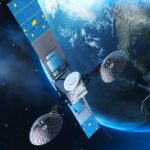It’s a beautiful clear night. The stars are out and the moon looks breathtaking against the sky, so you reach for your phone to take a snap. The results are,
phys.org11- Page
At a young age, we’re told how the sun warms Earth and makes life possible. That idea sticks with most of us for life. But when we want to understand
As a true milestone on the path to autonomous space systems, a research team at Julius-Maximilians-Universität Würzburg (JMU) has successfully tested an AI-based attitude controller for satellites directly in orbit—a
Space dust provides more than just awe-inspiring pictures like the Pillars of Creation. It can provide the necessary materials to build everything from planets to asteroids. But what it actually
There are no confirmed exomoons, moons orbiting distant exoplanets in other solar systems. There are a few candidates, but none have passed the threshold and been accepted as confirmed. But
New Glenn, the towering rocket built by Jeff Bezos’s space company Blue Origin, is set to take off on its second mission Sunday as competition intensifies with Elon Musk’s SpaceX.
Conditions on Venus’s surface have largely remained a mystery for decades. Carl Sagan famously pointed out that people were quick to jump to conclusions, such as that there are dinosaurs
A new study led by researchers from Oxford University, Southwest Research Institute and the Planetary Science Institute in Tucson, Arizona has provided the first evidence of significant heat flow at
After a three-year pause, Icarus, the pioneering project that tracks wildlife from space, is set to resume operations. On 11 November 2025, a rocket is scheduled to carry a satellite
Researchers at McGill University and collaborating institutions have mapped the atmospheric features of a planetary-mass brown dwarf, a type of space object that is neither a star nor a planet,
-
 012024 in Review: Highlights from NASA in Silicon Valley
012024 in Review: Highlights from NASA in Silicon Valley -
 02Panasonic Leica Summilux DG 15mm f/1.7 ASPH review
02Panasonic Leica Summilux DG 15mm f/1.7 ASPH review -
 03From Polymerization-Enabled Folding and Assembly to Chemical Evolution: Key Processes for Emergence of Functional Polymers in the Origin of Life
03From Polymerization-Enabled Folding and Assembly to Chemical Evolution: Key Processes for Emergence of Functional Polymers in the Origin of Life -
 04How New NASA, India Earth Satellite NISAR Will See Earth
04How New NASA, India Earth Satellite NISAR Will See Earth -
 05And Thus Begins A New Year For Life On Earth
05And Thus Begins A New Year For Life On Earth -
 06Astronomy Activation Ambassadors: A New Era
06Astronomy Activation Ambassadors: A New Era -
07SpaceX launch surge helps set new global launch record in 2024





